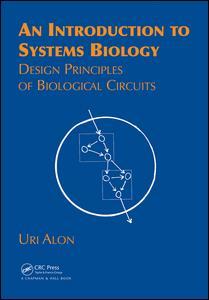Description
Introduction to Systems Biology & the Design Principles of Biological circuits (Mathematical & Computational Biology Series, Vol. 10)
Design Principles of Biological Circuits
Chapman & Hall/CRC Mathematical and Computational Biology Series
Author: Alon Uri
Language: English
Subjects for Introduction to Systems Biology & the Design Principles...:
An Introduction to Systems Biology
Publication date: 07-2017
· 17.8x25.4 cm · Hardback
Publication date: 07-2017
· 17.8x25.4 cm · Hardback
Approximative price 73.70 €
Subject to availability at the publisher.
Add to cart
Introduction to Systems Biology & the Design Principles of Biological circuits (Mathematical & Computational Biology Series, Vol. 10)
Publication date: 07-2006
300 p. · 17.8x25.4 cm · Paperback
Publication date: 07-2006
300 p. · 17.8x25.4 cm · Paperback
Description
/li>Contents
/li>Readership
/li>
Thorough and accessible, this book presents the design principles of biological systems, and highlights the recurring circuit elements that make up biological networks. It provides a simple mathematical framework which can be used to understand and even design biological circuits. The text avoids specialist terms, focusing instead on several well-studied biological systems that concisely demonstrate key principles. An Introduction to Systems Biology: Design Principles of Biological Circuits builds a solid foundation for the intuitive understanding of general principles. It encourages the reader to ask why a system is designed in a particular way and then proceeds to answer with simplified models.
INTRODUCTION. TRANSCRIPTION NETWORKS, BASIC CONCEPTS. The Cognitive Problem of the Cell. Elements of Transcription Networks. Dynamics and Response Time of Simple Gene Circuits. AUTO-REGULATION, A NETWORK MOTIF. Introduction. Patterns, Randomized Networks and Network Motifs. Autoregulation is a Network Motif. Negative Auto-Regulation Speeds the Response Time of Gene. Circuits. Negative Auto-Regulation Promotes Robustness to Fluctuations . in Production. Positive auto-regulation speeds responses and widens cell-cell variability. THE FEEDFORWARD LOOP NETWORK MOTIF. The Number of Appearances of a Subgraph in Random. Networks. The Feedforward Loop (FFL) is a Network Motif. The Structure of the Feedforward Loop Circuit. Dynamics of the Coherent FFL with AND-Logic. The C1-FFL is a Sign-Sensitive Delay Element. The Incoherent FFL: a pulse generator and response accelerator. Why Are Some FFL Types Rare?. Convergent Evolution of FFLs. TEMPORAL PROGRAMS AND THE GLOBAL STRUCTURE OF TRANSCRIPTION NETWORKS. The Single-Input Module (SIM) Network Motif. SIMs Can Generate Temporal Expression Programs. Topological Generalizations of Network Motifs. The Multi-Output FFL Can Generate FIFO Temporal Order. Signal Integration and Combinatorial Control: Bi-Fans and Dense-Overlapping Regulons. Network Motifs and the Global Structure of Sensory. Transcription Networks. NETWORK MOTIFS IN DEVELOPMENTAL, SIGNAL-TRANSDUCTION AND NEURONAL NETWORKS. Network Motifs in Developmental Transcription Networks: Positive feedback loops and bistability. Motifs in Signal Transduction Networks. Information Processing Using Multi-Layer Perceptrons. Composite Network Motifs: Negative Feedback and Oscillator . Motifs. Network Motifs in the Neuronal Network of C. Elegans. ROBUSTNESS OF PROTEIN CIRCUITS, THE EXAMPLE OF BACTERIAL CHEMOTAXIS. The Robustness Principle. Bacterial Chemotaxis, or How Bacteria 'Think'. The Chemotaxis Protein Circuit of E. coli. Two Models Can Explain Exact Adaptation, One is Robust and . the Other Fine Tuned. The Barkai-Leibler model. Individuality and Robustness in Bacterial Chemotaxis. ROBUST PATTERNING IN DEVELOPMENT. Introduction to Morphogen Gradients. Exponential Gradients Are Not Robust. Increased Robustness by Self-Enhanced Morphogen. Degradation. Network Motifs That Provide Robust Patterning. The Robustness Principle Can Distinguish Between. Mechanisms of Fruit Fly Patterning. KINETIC PROOFREADING. Kinetic Proofreading of the Genetic Code Can Reduce Error . Rates of Molecular Recognition. Recognition of Self and Non-Self by the Immune System. Kinetic Proofreading May Occur in Diverse Recognition . Processes in the Cell. OPTIMAL GENE CIRCUIT DESIGN. Cost and Benefit Analysis of Gene circuits. Optimal Expression Level of a Protein Under Constant. Conditions To Regulate or Not to Regulate: Optimal Regulation in Variable . Environments. Environmental Selection of the Feedforward Loop Network Motif. Summary. RULES FOR GENE REGULATION BASED ON ERROR MINIMIZATION. The Savageau Demand Rules. Rules for Gene Regulation Based on Minimal Error Load. Demand Rules for Genes with Multiple Regulators.
Students, researchers, biologists, biophysicists, bio-engineers, bio-mathematicians and practitioners in bioinformatics, computational biology
© 2024 LAVOISIER S.A.S.
These books may interest you

Engineering Genetic Circuits 74.82 €



